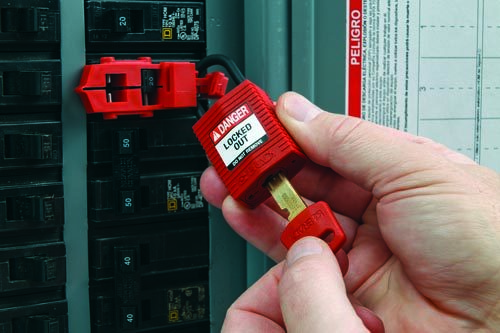Lockout/tagout needs
What features should I be looking for in a lockout padlock?

Replying is Tom Smith, regional product manager, Brady Corp., Milwaukee.
Quite a few factors should be looked at, including your lockout program size and complexity, organizational needs, and specific application needs – such as electrical or nonelectrical.
Large facilities with complex lockout/tagout programs
Managing a lockout/tagout program for multiple departments or facilities creates additional complexities to consider when selecting safety padlocks.
Finding a lock with a secure keyway (where the key can’t be duplicated at a hardware store) and enough unique key codes to ensure there’s no key duplication is a big challenge made even greater by key systems that can limit the number of available key codes. Look for a padlock with the highest number of unique key codes, even with these different keying options:
Keyed-different padlocks: With each padlock having its own unique key, this option often provides the most unique key code variety. When it’s mission critical to ensure every lock in the facility is unique, request keyed-different padlocks with key charting or key recording. This is ideal for avoiding key duplication when multiple maintenance personnel need to lock out equipment.
Keyed-alike padlocks: Also providing the most unique key code variety, this option uses the same key to open each padlock. Keyed-alike padlocks are beneficial when multiple locks are assigned to a single employee, as long as you remember that OSHA requires that no employee should be able to open a lock applied by someone else.
Master-keyed padlocks: The master key can open all locks, including keyed-alike and keyed-different locks, but delivers fewer unique key codes. This option makes it easier for a supervisor to remove a lock in an emergency.
Grand master-keyed padlocks: The grand master key can open all locks grouped into two or more master-keyed systems, but limits the number of unique key codes available. Use this option for larger teams requiring multiple levels of supervisory access.
Organizing your padlocks
After determining the right key system, consider the most efficient organization to keep track of your padlocks. Color-coding, engraving or lock labels help identify machine maintenance status, personnel or departments involved, as well as reduce the incidence of misplaced or lost padlocks to help ensure compliance.
Color-coding helps differentiate locks by trade, department or job function, and visually communicates who’s still working on a machine. Or, color-code your locks by facility location to help reduce losses when working with outside contractors.
Engraving is a more permanent way to keep organized. Consider engraving the department name on each lock and key code for easy matching.
Lock labels easily organize padlocks that can be quickly updated with employee names or pictures using an onsite printer. Pair them with long-bodied padlocks to accommodate languages or additional details such as department, phone number or photo.
Electrical implications for padlocks
When locking out equipment where there’s risk of arc flash or electrical conductivity, make sure to use a padlock that fits your workspace and won’t increase the risk of injury.
Nonconductive and non-sparking materials: Look for nylon-body padlocks with nylon shackles and nonconductive ball bearings and drivers to ensure the padlocks don’t close any circuits or create an arc flash point.
Compact padlocks: When space is at a premium (e.g., a circuit breaker), compact padlocks are ideal and can often still accommodate a closed breaker box or electrical cabinet door.
Cable padlocks: For lockout needs for multiple circuit breakers, cable padlocks are ideal. This one padlock easily fits through a line of circuit breaker lockout devices so you only have to apply one lock overall.
Editor's note: This article represents the independent views of the author and should not be construed as a National Safety Council endorsement.
Post a comment to this article
Safety+Health welcomes comments that promote respectful dialogue. Please stay on topic. Comments that contain personal attacks, profanity or abusive language – or those aggressively promoting products or services – will be removed. We reserve the right to determine which comments violate our comment policy. (Anonymous comments are welcome; merely skip the “name” field in the comment box. An email address is required but will not be included with your comment.)

